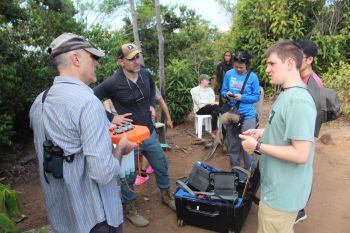New Research Shows Household Income Impacts of Hurricane Katrina and Superstorm Sandy, Need for More Equitable Climate Resilience Planning for Cities
CHICAGO—A new analysis of the economic impacts of Hurricane Katrina and Superstorm Sandy could help improve climate resilience planning for cities anticipating severe weather events going forward.
While many studies have examined the storms’ economic impact through loss of business revenue, Illinois Institute of Technology Associate Professor of Social Science Yuri Mansury and his colleagues focused on households’ income and properties by looking at which populations saw the most economic harm from the storms and why.
The lowest-income households in New Orleans, which were also predominantly African-American households, suffered the most as a result of Hurricane Katrina. Many of these households were dependent on employment in the mining industry or on capital earnings—namely, income received from owning mom-and-pop shops or owning property as landlords. Households earning less than $10,000 annually lost nearly 35 percent of their income and those earning between $10,000–$15,000 lost nearly 12 percent of their income.
In New York, it was downtown Manhattan and the highest-income households in the state that suffered the most as a result of Superstorm Sandy. Those households relied on labor income, worker’s compensation and salaries, and most were employed in the financial sector. Households earning more than $150,000 annually had an income loss of about 5.8 percent. Capital income was a secondary source of income for some of the highest-earning households.
Mansury says these types of studies have important implications for economic development and climate resilience planning in cities. Diversification of income sources is important for the lowest-income households to make them less vulnerable to disruption in their livelihood following an extreme weather event. Likewise, he says affluent areas also need diversified income sources to ensure that households are not dependent on a single industry or economic sector.
“When we think about the definition of a disaster, it is a combination of a hazardous event like Katrina and the preexisting stratification and existing inequality in the economy. If a disaster hits an empty area, it’s just a natural hazard. But it becomes a disaster if it hits a densely populated area,” says Mansury, who notes that about 60 percent of Americans now live in coastal cities. “The trend in which we observe the relocation of Americans to coastal cities is contributing to that, and more so, for households at the bottom of the distribution, they’re not able to afford more protected areas; they’re more exposed.”
The researchers used geographic information systems to examine patterns of economic activity that existed in New Orleans and New York in the areas that ended up underwater following the storms. Using these maps alongside United States census data in a computational model, the researchers were able to examine the earnings of households employed by the businesses affected by the storms. In doing so they were able to understand the broader picture of households’ dependence on the economic sectors that were most impacted by the storms.
Mansury and his colleagues hope to ultimately understand how to mitigate future economic losses caused by extreme weather, especially among lower-income households. They are planning a follow-up study that will focus on understanding how quickly residents and households experience the economic impact of natural disasters. Salary loss is felt most quickly by people no longer receiving a paycheck because their workplace is underwater. The same applies to the property owners of businesses that are flooded.
“We want to focus on income loss that is more immediate, particularly for low-income households that have less cushion,” Mansury says. “We want to be able to anticipate and come up with a mitigation plan that takes into account the speed through which the effect is transmitted to vulnerable households.”
This research, “Structural Path Analysis of Extreme Weather Events: An Application to Hurricane Katrina and Superstorm Sandy,” was published in Applied Geography in November.
To learn more about this study, read this article on the Illinois Tech website




